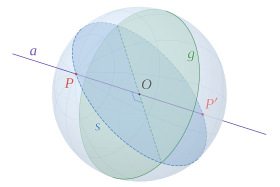

In mathematics, a great circle or orthodrome is the circular intersection of a sphere and a plane passing through the sphere's center point.[1][2]
Any arc of a great circle is a geodesic of the sphere, so that great circles in spherical geometry are the natural analog of straight lines in Euclidean space. For any pair of distinct non-antipodal points on the sphere, there is a unique great circle passing through both. (Every great circle through any point also passes through its antipodal point, so there are infinitely many great circles through two antipodal points.) The shorter of the two great-circle arcs between two distinct points on the sphere is called the minor arc, and is the shortest surface-path between them. Its arc length is the great-circle distance between the points (the intrinsic distance on a sphere), and is proportional to the measure of the central angle formed by the two points and the center of the sphere.
A great circle is the largest circle that can be drawn on any given sphere. Any diameter of any great circle coincides with a diameter of the sphere, and therefore every great circle is concentric with the sphere and shares the same radius. Any other circle of the sphere is called a small circle, and is the intersection of the sphere with a plane not passing through its center. Small circles are the spherical-geometry analog of circles in Euclidean space.
Every circle in Euclidean 3-space is a great circle of exactly one sphere.
The disk bounded by a great circle is called a great disk: it is the intersection of a ball and a plane passing through its center. In higher dimensions, the great circles on the n-sphere are the intersection of the n-sphere with 2-planes that pass through the origin in the Euclidean space Rn + 1.
YouTube Encyclopedic
-
1/3Views:59 6198 878739
-
Great Circles and Rhumb Lines - Types of Routes
-
Longitude and Latitude: Distances along Great Circles
-
07 Great Circle
Transcription
Derivation of shortest paths
To prove that the minor arc of a great circle is the shortest path connecting two points on the surface of a sphere, one can apply calculus of variations to it.
Consider the class of all regular paths from a point to another point . Introduce spherical coordinates so that coincides with the north pole. Any curve on the sphere that does not intersect either pole, except possibly at the endpoints, can be parametrized by
provided is allowed to take on arbitrary real values. The infinitesimal arc length in these coordinates is
So the length of a curve from to is a functional of the curve given by
According to the Euler–Lagrange equation, is minimized if and only if
- ,
where is a -independent constant, and
From the first equation of these two, it can be obtained that
- .
Integrating both sides and considering the boundary condition, the real solution of is zero. Thus, and can be any value between 0 and , indicating that the curve must lie on a meridian of the sphere. In a Cartesian coordinate system, this is
which is a plane through the origin, i.e., the center of the sphere.
Applications
Some examples of great circles on the celestial sphere include the celestial horizon, the celestial equator, and the ecliptic. Great circles are also used as rather accurate approximations of geodesics on the Earth's surface for air or sea navigation (although it is not a perfect sphere), as well as on spheroidal celestial bodies.
The equator of the idealized earth is a great circle and any meridian and its opposite meridian form a great circle. Another great circle is the one that divides the land and water hemispheres. A great circle divides the earth into two hemispheres and if a great circle passes through a point it must pass through its antipodal point.
The Funk transform integrates a function along all great circles of the sphere.
See also
References
- ^ W., Weisstein, Eric. "Great Circle -- from Wolfram MathWorld". mathworld.wolfram.com. Retrieved 2022-09-30.
{{cite web}}: CS1 maint: multiple names: authors list (link) - ^ Weintrit, Adam; Kopcz, Piotr (2014). Loxodrome (Rhumb Line), Orthodrome (Great Circle), Great Ellipse and Geodetic Line (Geodesic) in Navigation. USA: CRC Press, Inc. ISBN 978-1-138-00004-9.
External links
- Great Circle – from MathWorld Great Circle description, figures, and equations. Mathworld, Wolfram Research, Inc. c1999
- Great Circles on Mercator's Chart by John Snyder with additional contributions by Jeff Bryant, Pratik Desai, and Carl Woll, Wolfram Demonstrations Project.







![{\displaystyle S[\gamma ]=r\int _{a}^{b}{\sqrt {\theta '^{2}+\phi '^{2}\sin ^{2}\theta }}\,dt.}](https://wikimedia.org/api/rest_v1/media/math/render/svg/529ea36236f5ec3d9b1eba8447cc80ca1f04c1a0)
![{\displaystyle S[\gamma ]}](https://wikimedia.org/api/rest_v1/media/math/render/svg/fd04c39c6e63382ba18b7dcbea0096d75a472d34)








